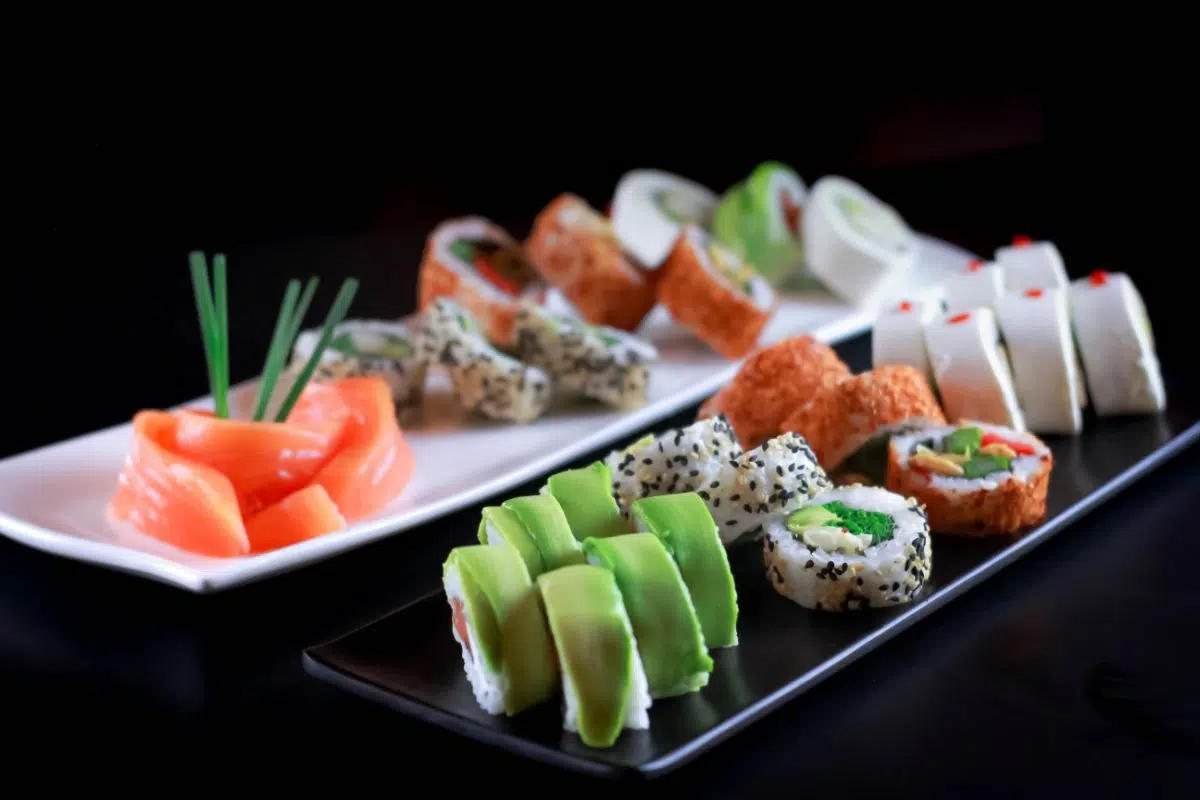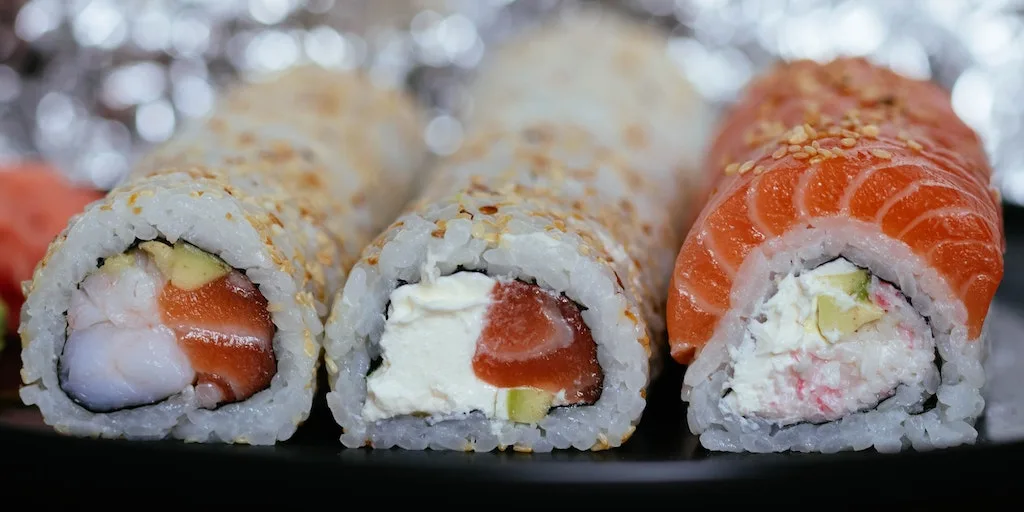Maki is a type of sushi that is enjoyed around the world.
Originating in Japan, maki is made by rolling sushi rice and various fillings, such as seafood, vegetables, or egg, in sheets of seaweed known as nori.

It is a popular and versatile sushi style that can be enjoyed in a variety of ways, including as a light snack, a part of a larger meal, or even as a party food.
In this article, we’ll explore the history of maki, the different types of maki rolls, and some tips on how to enjoy this beloved sushi style.
What Is Maki?
Maki is a type of sushi that originated in Japan and is made by rolling sushi rice and various fillings, such as seafood, vegetables, or egg, in sheets of seaweed known as nori.
The roll is then sliced into bite-sized pieces, typically served with soy sauce, wasabi, and pickled ginger.
Maki is one of the most popular and well-known types of sushi, with a wide range of varieties that can be enjoyed in many different ways, including as a light snack, a part of a larger meal, or even as party food.
In addition to traditional fillings, there are many creative and unique maki rolls that have become popular in recent years, making maki a versatile and fun food that can be enjoyed by sushi lovers of all tastes.
The History Of Maki
Maki sushi has been around in Japan for centuries, and its origins can be traced back to the Edo period in the 19th century.
During this time, sushi was sold in small stands and food stalls, and customers would often eat it on the go.
To make sushi more portable and easier to eat, chefs began to wrap the rice and fish in nori, creating the first maki rolls.
At first, maki was a relatively simple and unadorned food, made with just a few ingredients.
But as sushi grew in popularity and chefs became more creative, maki evolved into the complex and varied dish that it is today.
Today, there are countless types of maki, ranging from simple rolls with just one or two ingredients, to more elaborate rolls with multiple layers of fish, vegetables, and other fillings.
In the mid-20th century, sushi began to spread beyond Japan and become popular around the world, and maki was one of the first types of sushi to gain widespread popularity.
Today, maki is a beloved dish enjoyed by sushi lovers of all backgrounds, and is available in many different restaurants and food establishments around the globe.
Different Types Of Maki
There are many different types of maki, each with its own unique combination of fillings and flavors. Some of the most common types of maki include:

- Tekka maki: This is a simple maki made with just sushi rice, nori, and raw tuna.
- Kappa maki: A classic vegetarian maki made with cucumber and sushi rice.
- California roll: This popular maki is made with crab meat or imitation crab, avocado, and cucumber.
- Futomaki: This is a large and thick maki made with multiple ingredients, including egg, fish, and vegetables.
- Dragon roll: A more elaborate maki that often includes eel, avocado, and cucumber.
- Rainbow roll: A colorful maki made with a variety of fish, including tuna, salmon, and yellowtail.
- Spider roll: A popular maki made with deep-fried soft-shell crab and vegetables.
- Philadelphia roll: This maki includes cream cheese, smoked salmon, and avocado.
There are many other types of maki rolls, including some that are specific to certain regions or restaurants.
With so many different types of maki to try, there’s always something new and exciting to discover in the world of sushi.
Maki Health Benefits
Maki can be a healthy food choice, depending on the ingredients used to make it.
Here are some potential health benefits of maki:
- High in protein: Many types of maki are made with fish or seafood, which are excellent sources of protein. Protein is important for building and repairing tissues in the body, and can help you feel full and satisfied after a meal.
- Low in calories: Maki is often lower in calories than other types of sushi, such as nigiri or sashimi. This is because maki typically contains a smaller portion of rice and a higher proportion of vegetables or seafood.
- Contains healthy fats: Fish and seafood used in maki are rich in omega-3 fatty acids, which have been shown to have a range of health benefits, including reducing inflammation and improving heart health.
- Provides vitamins and minerals: Depending on the ingredients used, maki can be a good source of vitamins and minerals, such as vitamin A, vitamin C, calcium, and iron. For example, rolls made with avocado or sweet potato can provide a good dose of vitamin E and fiber.
- May help with weight management: Because maki is relatively low in calories and high in protein, it can be a satisfying and filling meal that may help with weight management goals.
It’s worth noting that the nutritional value of maki can vary widely depending on the ingredients used, as well as the portion size and preparation method.
To make the healthiest choices when it comes to maki, look for rolls that include a variety of vegetables and seafood, and opt for smaller portion sizes to keep calories in check.

How To Enjoy Maki
Maki is a versatile food that can be enjoyed in many different ways.
Here are some tips for how to enjoy maki:
- Dip it in soy sauce: Maki is typically served with soy sauce for dipping. You can pour the soy sauce into a small dish and dip each piece of maki before eating.
- Use wasabi and ginger: Wasabi and pickled ginger are often served with maki, and can add a bit of extra flavor and spice to your sushi.
- Eat it with chopsticks: While it’s possible to eat maki with your hands, it’s traditional to use chopsticks to pick up each piece of sushi.
- Enjoy it as part of a larger meal: Maki can be a great appetizer or snack, but it’s also commonly served as part of a larger meal that includes other types of sushi, sashimi, or other Japanese dishes.
- Try different varieties: With so many different types of maki to choose from, it’s fun to try a variety of rolls and fillings to see which ones you like the best.
- Experiment with different condiments: While soy sauce, wasabi, and ginger are traditional condiments for maki, you can also try experimenting with other flavors and seasonings, such as sriracha, sesame oil, or citrus.
By following these tips and experimenting with different varieties of maki, you can discover the many different ways to enjoy this popular and versatile type of sushi.
Final Thoughts
Maki is a beloved type of sushi that has become popular around the world.
Whether you prefer classic fillings like tuna and cucumber, or more creative options like tempura shrimp and avocado, there is a maki roll for every taste preference.
With its flavorful fillings and distinctive presentation, maki is a fun and delicious way to enjoy sushi.
By understanding the basics of maki, from its history to its many varieties, you can better appreciate this beloved sushi style and the artistry behind it.

Ingredients
- 100 g sushi rice
- 1 sheet nori
- 2 tbsp vinegar
- soy sauce
- wasabi
- ginger
- sesame seeds optional
Recommended Fillings:
- raw tuna
- raw salmon
- Avocado
- Cucumber
- Crab sticks
- Canned tuna mixed with mayo
- Prawns
Instructions
- Rinse the sushi rice in cold water until the water runs clear. Cook the rice according to the package instructions.
- While the rice is cooking, prepare your filling ingredients. Slice the tuna and salmon into thin strips. Cut the avocado into thin slices. Peel and slice the cucumber into thin sticks.
- Once the rice is cooked, transfer it to a bowl and add the sushi vinegar. Mix gently until the vinegar is fully incorporated into the rice.
- Lay the nori sheet on a sushi mat, shiny side down. With wet hands, spread the sushi rice evenly over the nori sheet, leaving a 1cm gap at the top edge.
- Arrange the filling ingredients in a line along the bottom edge of the rice, making sure to distribute them evenly.
- Lift the edge of the sushi mat closest to you, and use it to roll the sushi tightly away from you. Apply gentle pressure as you roll to ensure the sushi stays firm.
- Once the sushi is rolled, use a sharp knife to slice it into bite-sized pieces.
- Serve the sushi with soy sauce, wasabi, sushi ginger and roasted white sesame seeds (optional).
- Enjoy your homemade Maki Sushi Rolls!
